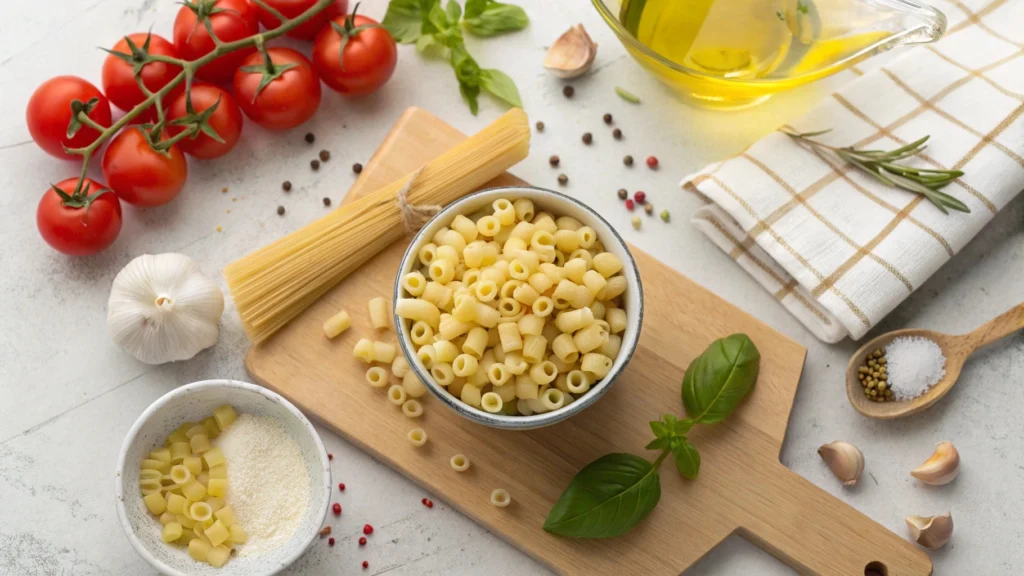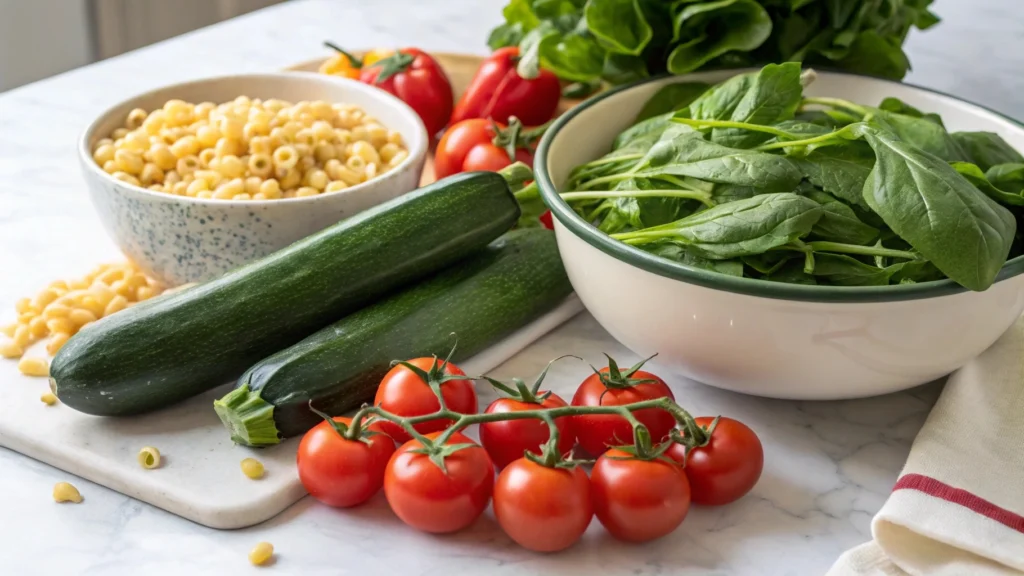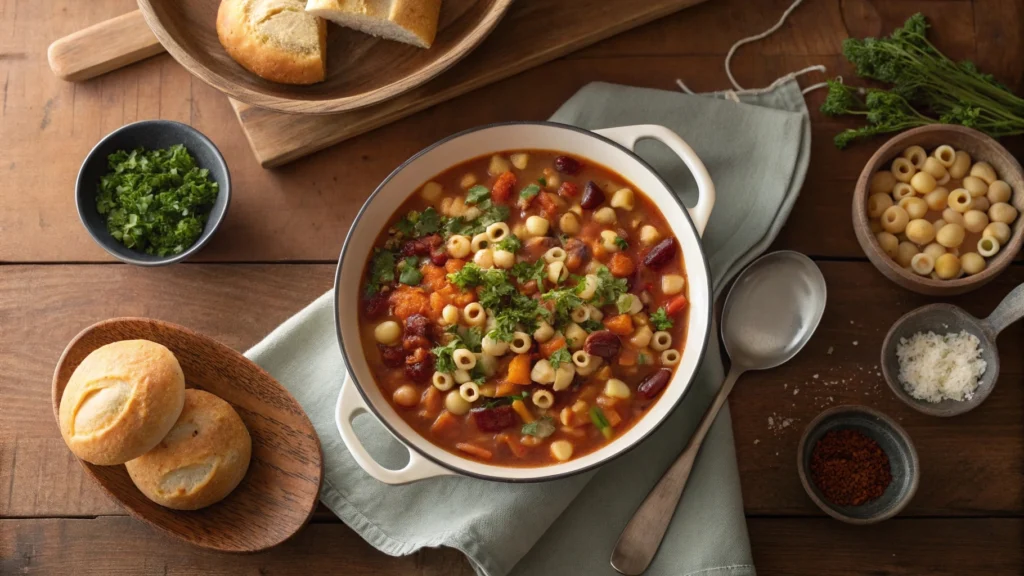There’s nothing worse than staring at your pantry, wondering what to make for dinner—especially when time is tight and you’re craving something comforting. That’s where this Ditalini Recipe swoops in to save the day! It’s the kind of meal that checks all the boxes: quick to make, budget-friendly, and surprisingly versatile. Whether you’re whipping up a hearty soup or a simple pasta salad, ditalini is like the MVP of pantry staples—small but mighty, and oh-so-satisfying.
The best part? You don’t need to be a pro in the kitchen to pull it off. This recipe keeps it simple with fresh, wholesome ingredients that come together in no time. Plus, it’s perfect for customizing—add veggies, protein, or whatever you’ve got on hand. It’s like the little black dress of recipes: it works for every occasion!
So, grab your favorite pot and get ready to create something delicious. Keep reading, because this is one recipe you’ll want to make on repeat!
Why Ditalini Pasta is a Kitchen Staple
A Versatile Ingredient for Quick Ditalini Recipes
Ditalini pasta is like the unsung hero of quick, delicious meals. Its small, tube-like shape makes it the perfect match for soups, salads, or creamy pasta dishes. First, it cooks up faster than larger pasta, which means you can whip up a meal in no time. Next, it’s super easy to portion, so you never end up making way too much (or not enough). And because it’s so versatile, you can toss it with pretty much any sauce, protein, or veggie you have in the fridge. Need a quick weeknight dinner? Ditalini to the rescue! It also absorbs flavors beautifully, so whether you’re making a tangy pasta salad or a rich soup, every bite is packed with taste. Honestly, once you try this ditalini recipe, you’ll see why it deserves a permanent spot in your pantry. It’s a total game-changer for busy cooks like you!
Need inspiration? This versatile ingredient is highlighted beautifully in this Easy Taco Soup Recipe where it absorbs flavors beautifully, adding both texture and taste.

Ditalini’s Unique Shape and Perfect Pairings
The beauty of ditalini lies in its fun, unique shape. Those tiny, tube-like pieces aren’t just adorable—they’re functional, too! First, their small size means they soak up sauces and broth like little sponges, making every bite extra flavorful. Then, they’re the perfect choice for recipes where you want the pasta to mix well with other ingredients, like soups, stews, or casseroles. And let’s not forget how kid-friendly it is! Whether you’re making mac and cheese or a pasta salad, those little tubes are easy to eat and so fun for kids (and, let’s face it, adults too). Pair them with a hearty tomato sauce, a simple olive oil drizzle, or even a creamy Alfredo—ditalini can handle it all. After one bowl of this ditalini recipe, you’ll wonder how you ever made soups or pasta without it. It’s like a pasta-shaped hug in every dish!
How to Make the Ultimate Ditalini Recipe at Home
Step-by-Step Instructions for Beginners
Making this ditalini recipe is easier than you think. First, bring a pot of salted water to a boil. Once it’s bubbling, toss in the ditalini pasta and cook it for about 8-10 minutes. While the pasta is cooking, grab a pan and start prepping your sauce. For beginners, a simple marinara or olive oil with garlic and herbs is a great starting point. Then, drain the pasta—but don’t rinse it! The starch helps the sauce stick to those little tubes. Add the pasta to your sauce, mix it all together, and let it cook for another minute or two to soak up all the flavors. Serve it hot, and voilà—you’ve got a delicious dish ready to go! Trust me, this is one ditalini recipe you’ll keep coming back to, especially when you need a quick, no-fuss meal.
If you’re looking for another comforting dish with ditalini inspiration, don’t miss this Boulders Enchilada Recipe that showcases ditalini’s versatility in cold dishes too.
Quick Prep Tips to Save Time
If you’re always in a rush, don’t worry—this ditalini recipe has you covered. First, start by prepping your ingredients before you even boil the pasta. Chop your veggies, measure out your spices, and have your sauce ready to go. Next, use store-bought broth or canned tomatoes for soups to save time without losing flavor. Want even more convenience? Keep cooked ditalini in the fridge for up to three days, so you can just toss it into your meals when you’re short on time. Another tip? Use frozen veggies—they’re already chopped and ready to go! Plus, they’re just as nutritious as fresh ones. Finally, don’t forget to set a timer when cooking your pasta—it’s easy to get distracted, and nobody likes mushy ditalini. With these tricks, you’ll have this ditalini recipe on the table faster than you can say “dinner’s ready!”
Ingredients That Elevate Your Ditalini Dish
Fresh and Simple Staples for Maximum Flavor
The secret to an amazing ditalini recipe is starting with fresh, simple ingredients. First, grab high-quality ditalini pasta—it really makes a difference! Next, stock up on basics like garlic, olive oil, and fresh herbs. These add bold, natural flavors without making things complicated. Tomatoes—either fresh or canned—are a must-have for sauces or soups. Add in some fresh veggies like spinach, zucchini, or bell peppers for a pop of color and nutrients. Don’t forget your cheese! Parmesan or mozzarella can take your dish to the next level. Also, using good-quality broth for soups makes the flavors even richer. Trust me, when you use fresh, simple staples, every bite of this ditalini recipe feels like pure comfort. It’s filling, flavorful, and so satisfying!

Optional Add-Ins for a Customized Twist
One of the best things about this ditalini recipe is how you can change it however you like. Want some protein? Add grilled chicken, sausage, or even shrimp for a heartier meal. Love veggies? Toss in whatever you’ve got—broccoli, mushrooms, or peas work great. Feeling adventurous? Try adding a splash of cream or a pinch of chili flakes for a spicy kick. You can even go the Mediterranean route with olives, sun-dried tomatoes, and feta cheese. The possibilities are endless! It’s the perfect dish for using up leftovers or experimenting with new flavors. Plus, every tweak makes it feel like a brand-new recipe. So, grab your favorite ingredients and have fun with it—this ditalini recipe is yours to make your own!
Best Ways to Serve Your Ditalini Recipe
From Soups to Salads: Ditalini Done Right
Ditalini pasta isn’t just for one type of dish—it’s a total multitasker. For instance, pair it with hearty beans or rich broth for a classic pasta e fagioli soup. Or try incorporating it into unique creations like the Chicken Breakfast Recipes that blend creativity with morning comfort. Whether baked into casseroles or tossed into simple olive oil and Parmesan, this pasta always shines.. It’s light, fresh, and great for picnics or potlucks. Also, ditalini works beautifully in creamy casseroles, especially with gooey cheese baked on top. Looking for something super simple? Just toss it with olive oil, garlic, and Parmesan—it’s like a warm, comforting hug in a bowl. No matter how you serve it, this ditalini recipe always shines. It’s versatile, easy, and guaranteed to please everyone at the table.
Creative Serving Ideas for Family Dinners
When it comes to family dinners, this ditalini recipe is a total winner. First, try serving it family-style in a big bowl with a variety of toppings on the side. Everyone can customize their dish just how they like it. Next, make a hearty baked ditalini casserole for a no-fuss one-dish meal. Add some garlic bread on the side, and you’ve got a dinner that feels special but is super easy to make. Also, ditalini is great for picky eaters. Its small size makes it fun to eat, and you can sneak in veggies without anyone noticing. For a fun twist, serve it as a DIY pasta bar with different sauces and toppings. It’s interactive and perfect for getting kids involved in the kitchen. Trust me, this ditalini recipe will quickly become a family favorite!

Tips for Storing and Reheating Ditalini Dishes
How to Keep Ditalini Fresh Without Losing Texture
Storing leftover ditalini dishes is super simple if you know a few tricks. First, always let your pasta cool completely before putting it in the fridge. This helps prevent it from getting soggy. Next, store it in an airtight container to lock in freshness. If you’ve mixed the pasta with sauce, add a tiny drizzle of olive oil before sealing the container. This keeps the pasta from sticking together. Also, try to eat it within three days for the best taste and texture. If you’re storing plain cooked ditalini, keep it separate from the sauce. This way, you can reheat them together without the pasta getting mushy. With these tips, your ditalini recipe will taste just as good the next day as it did when you made it!
Reheating Techniques for That Just-Cooked Taste
Reheating your ditalini recipe doesn’t have to mean sacrificing flavor. First, use a skillet instead of a microwave for better results. Add a splash of water or broth to the pan, toss in your pasta, and heat it gently over medium heat. This keeps the pasta from drying out and helps bring back that fresh-made taste. If you’re using the microwave, cover the dish with a damp paper towel to keep it moist. Reheat in short bursts, stirring in between, to avoid overheating. For soups, just warm them in a pot over the stove, adding a little extra broth if needed. Want to jazz up your leftovers? Sprinkle some fresh herbs or a little extra cheese on top before serving. These tricks will make your ditalini recipe taste like it’s fresh off the stove every time!
Frequently Asked Questions (FAQs)
What does ditalini mean in Italian?
Ditalini literally means “little thimbles” in Italian. Cute, right? The name comes from their tiny, tube-like shape, which looks like a thimble. Traditionally, ditalini pasta has been used in soups, especially in Italian dishes like pasta e fagioli. It’s the perfect size for scooping up with a spoon, which is why it works so well in brothy or hearty soups. In Italian cuisine, pasta shapes often match the dish they’re meant for, and ditalini is no exception. Once you try a ditalini recipe, you’ll see why Italians love it so much—it’s small, but packed with possibilities!
What is ditalini pasta similar to?
If you can’t find ditalini, don’t worry! It’s similar to other small pasta shapes like macaroni, tubetti, or even orzo. Like ditalini, these shapes are great for soups, salads, and casseroles. Macaroni is slightly curved, while tubetti is another straight, tube-like option. Orzo is more rice-shaped but works well in similar recipes. Each shape has its own charm, but ditalini is unique because of its perfect size and smooth texture. Whatever you use, though, a ditalini recipe will still be just as delicious! Just pick a small pasta shape, and you’re good to go.
What is the difference between ditalini and ditali pasta?
Ditalini and ditali pasta are super similar, but there’s a tiny difference. Ditalini, or “little thimbles,” is smaller and more petite. Ditali, on the other hand, is slightly larger and chunkier. Think of ditalini as the perfect pasta for soups and light dishes, while ditali works well in heartier meals like baked pasta or thick casseroles. Both shapes have that signature tube-like design, so they hold sauces and flavors beautifully. You can totally swap them in most recipes, though! Whether you use ditali or ditalini, your recipe will still turn out amazing.
Is ditalini pasta healthy?
Ditalini pasta can be part of a healthy meal, especially when paired with nutritious ingredients. First, it’s a great source of energy because it’s made from wheat, which gives your body fuel. Next, you can mix it with fresh veggies, lean proteins, or even beans for a balanced dish. Whole wheat ditalini is another option if you’re looking for extra fiber. Like any pasta, it’s all about what you serve it with. A ditalini recipe loaded with veggies and a light sauce can be both filling and good for you. Plus, it’s a comfort food that fits into most healthy diets!
Conclusion
Wrap It Up: Why This Ditalini Recipe Deserves a Spot in Your Meal Rotation
And there you have it—this Ditalini Recipe is everything you could want in a meal. It’s quick, comforting, and so easy to make. First, its small, tube-like shape makes it perfect for soups, salads, and pasta dishes. Next, it’s versatile enough to work with whatever you have on hand, whether that’s fresh veggies, hearty proteins, or a simple sauce. Then, there’s the fact that it’s fun to eat and always satisfying. Plus, it’s beginner-friendly and a total lifesaver on busy nights. Honestly, this recipe is the definition of a kitchen staple. So, grab some ditalini, roll up your sleeves, and get cooking. Whether you’re making a cozy soup or a hearty casserole, this dish will become a go-to in your weekly lineup. Trust me, once you try it, you’ll wonder how you ever cooked without it. Your taste buds—and your schedule—will thank you!
